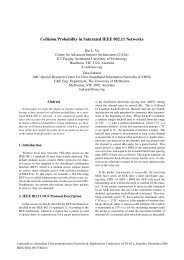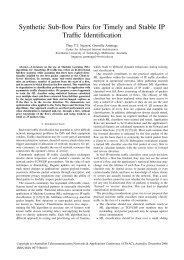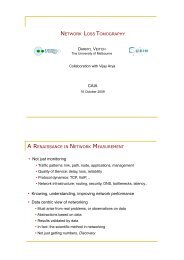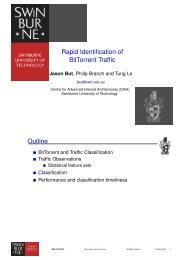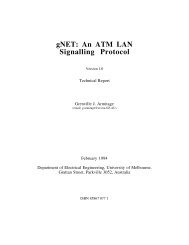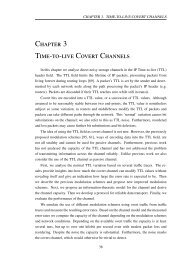Mitigating Sampling Error when Measuring Internet Client IPv6 ...
Mitigating Sampling Error when Measuring Internet Client IPv6 ...
Mitigating Sampling Error when Measuring Internet Client IPv6 ...
Create successful ePaper yourself
Turn your PDF publications into a flip-book with our unique Google optimized e-Paper software.
Figure 1: Experimental setup<br />
<br />
<br />
<br />
<br />
The JS-test uses cookies to ensure clients are only tested once<br />
every 24 hours (per web site). The main reason for this is to reduce<br />
the load on our test servers. However, some clients may ignore<br />
the JS-test cookies and perform the test multiple times within 24<br />
hours. The FA-test cannot use cookies due to Google’s restrictions,<br />
so clients may be tested multiple times. For both tests there can<br />
be web proxies or NATs in front of multiple clients that look like<br />
repeating clients. Nevertheless, the number of IPs repeating the test<br />
within 24 hours is low (see Section 3.1)<br />
2.4 User impact<br />
The JS-test is only executed after the web page has loaded completely.<br />
Hence it does not delay the loading of the page. The JS-test<br />
script is 12 kB large (including the Google Analytics code). The<br />
loading of the FA-test is controlled by Google. Our ad is only 16 kB<br />
large, not larger than many other ads and well below Google’s size<br />
limit of 50 kB. The test images are only 157 bytes large and invisible<br />
(loaded but not displayed). The total size of the test data<br />
transferred is well under 20 kB, less than 6% of the average web<br />
page size of 320 kB (as determined in [21]).<br />
Our test opens six different TCP connections to download the<br />
test images (five for the sub-tests plus one for the summary). The<br />
download is done in the background by the browsers. The maximum<br />
number of concurrent open connections is at least 30 for<br />
most browsers [22]. Whether the test connections will cause existing<br />
connections to be closed depends on how many connections<br />
are already open. But in any case the test does not affect the loading<br />
of the current page and the next page will not load slower than<br />
<strong>when</strong> loaded for the first time.<br />
We argue that overall our test does not have a significant impact<br />
on the user’s browsing experience. We conducted a few simple tests<br />
in which test users did not experience any noticeable impact. Also,<br />
our test does not trick users into revealing any sensitive information.<br />
Instead, we utilise information that web clients normally send<br />
to every visited web server.<br />
3. DATASET<br />
We use the data collected between 16 th of May 2011 and 19 th<br />
of February 2012. We discarded 1% of tests as “invalid”, such as<br />
tests with malformed or truncated URLs in the server logs. We also<br />
discarded tests of clients referred by three large web sites that only<br />
Tests [k]<br />
400<br />
300<br />
200<br />
100<br />
0<br />
●<br />
16May<br />
2011<br />
●<br />
25Jun<br />
2011<br />
Total number of tests<br />
04Aug<br />
2011<br />
●<br />
13Sep<br />
2011<br />
●<br />
Date<br />
23Oct<br />
2011<br />
●<br />
02Dec<br />
2011<br />
11Jan<br />
2012<br />
●<br />
● Total<br />
Complete<br />
20Feb<br />
2012<br />
Figure 2: Total number of tests and number of completed tests<br />
per day<br />
Number of tests per IP address<br />
CDF<br />
1.00<br />
0.98<br />
0.96<br />
0.94<br />
●<br />
0 5 10 15 20 25<br />
Number of tests per IP address<br />
● JS<br />
FA<br />
Figure 3: Number of tests per day per IP address for JS-test<br />
and FA-test<br />
participated for one or two days. We analyse the data in blocks of<br />
days (24 hours). However, we will present most of the statistics<br />
averaged over weekly periods to reduce the error of the estimates.<br />
We now describe the properties of our dataset.<br />
3.1 Number of tests<br />
Figure 2 shows the weekly averages of the number of total and<br />
completed (with test summary) tests per day. Apart from the initial<br />
period the total number of tests per day was 250 000–300 000 and<br />
the number of completed tests was 180 000–200 000 per day (of<br />
which 30 000–35 000 were FA-tests and the rest were JS-tests).<br />
The statistics we present in Section 5 are proportions. If the sam-<br />
ples are independent, then the standard error for proportion esti-<br />
<br />
ˆp(1− ˆp)<br />
mates is SE = , where ˆp is the estimated proportion and n<br />
n<br />
is the number of samples. Generally, for our statistics the relative<br />
error is below 1% and hence we do not plot error bars. However,<br />
due to the way we sample the clients there is an additional sampling<br />
error, which we discuss in Section 4.<br />
Figure 3 shows the CDFs of the number of tests per day for each<br />
IPv4 address. FA-tests have a higher repeat rate (FA-tests cannot<br />
use cookies), but it is only slightly higher since Google distributed<br />
the ads well. Less than 8% of IPs performed the test more than<br />
once per day and less than 0.1% (JS-test) or 0.3% (FA-test) of IPs<br />
performed the test more than 10 times per day. This suggests that<br />
single IPs do not dominate our statistics.



